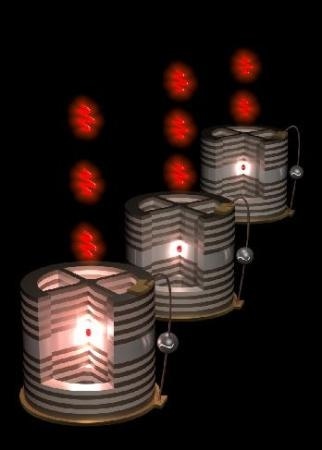Mar 9 2016
A new ultra-bright source of single photons - 15 times brighter than commonly used sources and emitting photons that are 99.5% indistinguishable from one another - has been developed by researchers from the CNRS, Université Paris Diderot, and Université Paris-Sud1.
 This image represents three sources of single photons: represented by a red dot at the center of the cavity, the semiconductor quantum dots (of nanometric size) is inserted in the center of the cavity, which consists of a 3 µm pillar connected to a circular frame by guides that are 1.3 µm wide. By applying electrical voltage to the cavity, the wavelength of the emitted photons can be tuned and the charge noise totally eliminated. (credit: © Niccolo Somaschi – Laboratoire de photonique et de nanostructures (CNRS))
This image represents three sources of single photons: represented by a red dot at the center of the cavity, the semiconductor quantum dots (of nanometric size) is inserted in the center of the cavity, which consists of a 3 µm pillar connected to a circular frame by guides that are 1.3 µm wide. By applying electrical voltage to the cavity, the wavelength of the emitted photons can be tuned and the charge noise totally eliminated. (credit: © Niccolo Somaschi – Laboratoire de photonique et de nanostructures (CNRS))
This feat was achieved thanks to the nanometrically-precise positioning of a quantum dot2 within an optical microcavity. Adding an electrical control to the device helped reduce the "noise" around the quantum dot, which generally renders photons different from one another. Obtained in collaboration with researchers from Brisbane (Australia), these results make it possible to conduct quantum computing of unprecedented complexity, a first step toward the creation of optical quantum computers. The results will be published in Nature Photonics on March 7, 2016.
Notes:
1 The French laboratories involved are the Laboratoire de photonique et nanostructures (LPN-CNRS), and the Institut Néel (CNRS). PhD students from the Université Paris-Sud and Université Grenoble Alpes have contributed to this study. Pascale Senellart is also an academic at the École polytechnique.
2 Quantum dots are semiconductor nanocrystals whose dimensions are typically 20 nanometers (20 billionths of a meter). By virtue of their size, they serve as a potential well which confines the charge carriers in the three dimensions of space, i.e. a few dozen nanometers in a semiconductor. This confinement gives quantum dots properties close to those of a unique atom.
Bibliography:
Near Optimal Single Photon Sources in the Solid State. Niccolo Somaschi, Valérian Giesz, Lorenzo de Santis, Juan Carlos Loredo, Marcelo Almeida, Gaston Hornecker, Simone Luca Portalupi, Thomas Grange, Carlos Anton, Justin Demory, Carmen Gomez, Isabelle Sagnes, Norberto Daniel Kimura, Aristide Lemaître, Alexia Auffèves, Andrew G. White, Loic Lanco and Pascale Senellart, Nature Photonics, 7 march 2016. DOI:10.1038/Nphoton.2016.23.